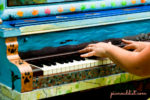Learning Styles: Intuitives ~ Sensers
This is the second in our series about the four learning style pairs of Isabel Meyers-Briggs and how they apply to music teaching and learning. (see Learning Styles: Introversion ~ Extroversion 7/27/10 and Learning in Style 7/26/10). Do you have an Intuitive or a Sensor in your life? Do you yourself have strong tendencies toward one side or the other? Read on…
T. J. is an Intuitive
T. J. thinks and discusses in large spontaneous leaps, trusting in hunches and instincts. He sometimes doesn’t pay attention to the practical or the here and now and so, jumps to conclusions.
T.J. Naturally generalizes and sees “the forest”. He easily understands the “rules” behind things like scale fingerings and style periods.
T.J. may be inattentive to details or perform with a lack of precision. His performances have “panache”.
T.J. is always on the lookout for possibilities, theories, “the new” and he is at his best working with ideas or issues that have many facets.
T.J. can be impatient with monotonous tasks (like practicing). He often complains he is bored with his work.
Bill is a Senser
Bill thinks and converses in details and facts He sees “the trees”. He is generally patient and methodical about his work. He often mistrusts his “inner voice”
Bill may become so mired in the details of the music that he loses sight of possibilities – “the forest”, He forgets to look for a larger form or to consider what the composer was trying to say in the first place.
Bill is frustrated by complex, intricate, or thorny problems that need to be worked out. He needs simplification, explanation, and to have thorny problems organized into small units or steps.
Bill resists setting long-term goals and imagining the consequences of his actions. He is content in the present and generally does not imagine the future.
Students like Bill have a great need for organization. It is important to think in “baby steps” when choosing materials or planning activities. Bill does very well with “on your own pieces” if they are carefully presented so that they connect and integrate to his past experiences and learning. Connecting new theory activities to prior knowledge and experience in repertoire may be especially important for Bill because his former teacher did not emphasize theory and that area is currently far behind his repertoire and technique levels.
Last year T.J.’s teacher decided to “cure” what she considered to be sloppy learning habits. She implemented a very regimented plan for each concept and piece and refused to allow T.J. to practice the whole until he had perfected each part. Since T.J.’s need to see the forest was completely blocked he became unhappy, confused, and uncooperative. T.J.’s teacher made the mistake of trying to do too much too fast. Moving a student toward the opposite characteristic or style must be done with sensitivity and care. Too much too fast can result in a kind of discontinuity which can be threatening and you may find a very confused, unhappy and occasionally hostile student on your hands.
Both T.J. and Bill do well with discovery-based learning. Effective materials contain lots of guiding questions to help Bill see the big picture and T.J. find the important details. Both boys benefit from lesson activities which compare and contrast style or interpretation, create maps of form or notation, explore the science of music, or encourage new levels of listening. They often work together or in a larger group to improve Bill’s ability to synthesize facts and T.J’s ability to discover the theory behind those facts.
When the boys began to work together the teacher assumed that Bill and T.J. would find a middle road between facts and instinct on their own. Without clear guidance from the teacher in the form of an organized plan and a problem solving approach the boys “exchanged personalities” and refused to work together at all. Bill considered T. J. an unprepared showoff and T.J. considered Bill a nerd who didn’t have a clue about what was real. Now she presents new concepts and skills as problems placed in a recognizable settings and the boys are working together much more successfully.
Both intuitives and sensers benefit from structure and organization. When beginning a new learning experience the senser needs to have familiar facts presented through activities which are hands on and then move to include broader patterns and concepts. The intuitive student needs to needs to work backwards from the broader concept to the details and hands on experience and to understand, “Why should I learn this?”
Remember too, that teachers have primary learning styles. These learning styles can become primary teaching styles. We fall back on what is most comfortable. It isn’t laziness. It’s just human nature. When this happens we cease being able to listen to the other person and understand their point of view. We begin to impose our own style upon the other person. Facts, skills, and concepts are not the issue here–finding ways to help an individual person connect to those facts, skills, and concepts and internalize them is.


